An Emotional Canvas Therapeutic Exercise


Written and verified by the psychologist Valeria Sabater
How are you feeling right now? Are you calm? Or, are you overwhelmed by stress and anxiety? Perhaps you wouldn’t even know how to explain how you’re feeling. As surprising as it may seem, most of us find it difficult to make contact, identify, and express our emotions. They’re like skeins of colored threads that we don’t know how to unravel.
In fact, almost without realizing it, we move through our everyday lives with these threads being knotted. They’re those difficult psychophysiological states that suffocate and completely condition us. After all, life is pressuring, and we have many obligations. However, every time we disregard our emotions, fertile ground appears in which psychological disorders can grow.
For these reasons, we need simple tools to put into words what we feel. There are some really practical techniques for this purpose. Indeed, we can all use our own resources, in order to stop acting on autopilot and repressing what we feel under infinite layers of psychological strata. In this article, we’ll provide a helpful strategy that’s both original and effective.
“Disturbing emotions and toxic relationships have been identified as risk factors that favor the appearance of some diseases.”
-Daniel Goleman-

The color of emotions and their labeling
Emotions not only facilitate adaptation to always complex environments but also drive human connection and encourage motivation for reaching goals and achieving purposes. In effect, your emotions have texture and color, and give meaning to your existence.
It’s only when you start to understand that every emotional state is like a colorful canvas, that you learn to handle yourself better in this respect. This is because you don’t process every experience, situation, and circumstance in a monochromatic way. Things are never simply good or bad. Suffering a breakup, dealing with grief, unemployment, or simple disappointment doesn’t always mean walking down a gray path.
In reality, there’s an extremely wide spectrum of shades (emotions) that you might experience in the same circumstances. Moreover, you need to know how to identify and, above all, label each one of them.
Research conducted by the University of California (USA) claims that emotional labeling reduces the response of the amygdala and other limbic regions associated with more difficult and distressing states. In other words, naming what hurts us favors emotional self-awareness and mood regulation. Next, we’ll examine a technique with the same goal.
Our difficult experiences can trace within us a really chaotic ‘color amalgamation’ of emotions. It’s hard to know what we feel. However, labeling each emotion benefits self-awareness and the ability to better manage those states of negative valence.
An emotional canvas exercise
This emotional canvas exercise aims to delve into your emotions and feelings in order to better identify and manage them. It’s a resource based on expressive techniques that connect with your interior. Gestalt therapy frequently makes use of this tool.
The aim is for you to leave out what you have inside you and find a channel to make contact with what’s interfering with your well-being. In addition, you must name each emotion you’re experiencing. Gestalt therapy was developed by Fritz Perls. It stresses the importance of focusing on the present moment to increase self-awareness and connect with emotional pain.
Exercise favors this same mechanism. Now, let’s see its steps.
What do you need?
To carry out this technique, you need a sketchbook and some colored pencils or oil paints. Use whichever you find most stimulating.
1. Step one: accept the full range of your emotions
Emotions aren’t a threat to you, even if they’re uncomfortable or painful. Therefore, the first step in the emotional canvas exercise is to accept, leave space, and give presence to each sensation that you feel inside. Indeed, art is the best channel for expressiveness and giving essential presence to each of your emotions.
Now, paint the blank sheet with the colors that best fit each of your sensations, emotions, and feelings. There’s no need to draw anything specific, just let yourself go. What matters most is creating a spectrum of great color and to make this technique a tool through which what you’re feeling flows.
2. Explore what you’ve created
Once your exercise of expression through color is finished, it’s time to observe what you did. However, make sure you pay attention to your sheet or canvas of vibrant tones without judgment. After all, it’s not intended to be a work of art.
In fact, the goal is to represent your internal emotional chaos on a blank sheet of paper. You must observe it meticulously and reflectively. This second step requires calm, serenity, and observational skills.
The emotional canvas technique unravels what you feel, through an exercise of artistic expression.
3. Name each emotion
What emotion does red signify for you in your drawing? What does black represent? How about green? You need to name every emotion that your drawing transmits to you. The emotional canvas exercise requires that you make use of emotional labeling. In effect, through a state of calm and reflection, you figure out everything that’s emerged from your creation.
Is there sadness? Is there disappointment? Do you sense the presence of anger, rage, or fear? Feel free to write it all down in a notebook.
4. Your favorite colors: the changes you need
What are your favorite colors? Let yourself be carried away by their tonality as you relax and use them on another blank sheet. Paint or draw whatever you want, while visualizing what you need to do to feel better. You’ve already made contact with your difficult emotions, now you must think about what to do with them.
You may feel you need to deal with something or alternatively, just do nothing. They may urge you to carry out some change or strategy that helps you feel better. Think about it as your favorite hues flood your gaze.

Final note
This exercise taken from art therapy or expressive therapy can be useful at any given time. It’s a way of untying the knot of your emotions and connecting with them. However, although it can reduce stress and allow you to become aware of what’s happening to you, it won’t always solve the root of the problem by itself.
For this reason, if you think you require specialized help, you shouldn’t hesitate to ask for it. Meanwhile, emotional exploration through colors is a resource that’ll always be within your reach. It’s well worth a try.
How are you feeling right now? Are you calm? Or, are you overwhelmed by stress and anxiety? Perhaps you wouldn’t even know how to explain how you’re feeling. As surprising as it may seem, most of us find it difficult to make contact, identify, and express our emotions. They’re like skeins of colored threads that we don’t know how to unravel.
In fact, almost without realizing it, we move through our everyday lives with these threads being knotted. They’re those difficult psychophysiological states that suffocate and completely condition us. After all, life is pressuring, and we have many obligations. However, every time we disregard our emotions, fertile ground appears in which psychological disorders can grow.
For these reasons, we need simple tools to put into words what we feel. There are some really practical techniques for this purpose. Indeed, we can all use our own resources, in order to stop acting on autopilot and repressing what we feel under infinite layers of psychological strata. In this article, we’ll provide a helpful strategy that’s both original and effective.
“Disturbing emotions and toxic relationships have been identified as risk factors that favor the appearance of some diseases.”
-Daniel Goleman-

The color of emotions and their labeling
Emotions not only facilitate adaptation to always complex environments but also drive human connection and encourage motivation for reaching goals and achieving purposes. In effect, your emotions have texture and color, and give meaning to your existence.
It’s only when you start to understand that every emotional state is like a colorful canvas, that you learn to handle yourself better in this respect. This is because you don’t process every experience, situation, and circumstance in a monochromatic way. Things are never simply good or bad. Suffering a breakup, dealing with grief, unemployment, or simple disappointment doesn’t always mean walking down a gray path.
In reality, there’s an extremely wide spectrum of shades (emotions) that you might experience in the same circumstances. Moreover, you need to know how to identify and, above all, label each one of them.
Research conducted by the University of California (USA) claims that emotional labeling reduces the response of the amygdala and other limbic regions associated with more difficult and distressing states. In other words, naming what hurts us favors emotional self-awareness and mood regulation. Next, we’ll examine a technique with the same goal.
Our difficult experiences can trace within us a really chaotic ‘color amalgamation’ of emotions. It’s hard to know what we feel. However, labeling each emotion benefits self-awareness and the ability to better manage those states of negative valence.
An emotional canvas exercise
This emotional canvas exercise aims to delve into your emotions and feelings in order to better identify and manage them. It’s a resource based on expressive techniques that connect with your interior. Gestalt therapy frequently makes use of this tool.
The aim is for you to leave out what you have inside you and find a channel to make contact with what’s interfering with your well-being. In addition, you must name each emotion you’re experiencing. Gestalt therapy was developed by Fritz Perls. It stresses the importance of focusing on the present moment to increase self-awareness and connect with emotional pain.
Exercise favors this same mechanism. Now, let’s see its steps.
What do you need?
To carry out this technique, you need a sketchbook and some colored pencils or oil paints. Use whichever you find most stimulating.
1. Step one: accept the full range of your emotions
Emotions aren’t a threat to you, even if they’re uncomfortable or painful. Therefore, the first step in the emotional canvas exercise is to accept, leave space, and give presence to each sensation that you feel inside. Indeed, art is the best channel for expressiveness and giving essential presence to each of your emotions.
Now, paint the blank sheet with the colors that best fit each of your sensations, emotions, and feelings. There’s no need to draw anything specific, just let yourself go. What matters most is creating a spectrum of great color and to make this technique a tool through which what you’re feeling flows.
2. Explore what you’ve created
Once your exercise of expression through color is finished, it’s time to observe what you did. However, make sure you pay attention to your sheet or canvas of vibrant tones without judgment. After all, it’s not intended to be a work of art.
In fact, the goal is to represent your internal emotional chaos on a blank sheet of paper. You must observe it meticulously and reflectively. This second step requires calm, serenity, and observational skills.
The emotional canvas technique unravels what you feel, through an exercise of artistic expression.
3. Name each emotion
What emotion does red signify for you in your drawing? What does black represent? How about green? You need to name every emotion that your drawing transmits to you. The emotional canvas exercise requires that you make use of emotional labeling. In effect, through a state of calm and reflection, you figure out everything that’s emerged from your creation.
Is there sadness? Is there disappointment? Do you sense the presence of anger, rage, or fear? Feel free to write it all down in a notebook.
4. Your favorite colors: the changes you need
What are your favorite colors? Let yourself be carried away by their tonality as you relax and use them on another blank sheet. Paint or draw whatever you want, while visualizing what you need to do to feel better. You’ve already made contact with your difficult emotions, now you must think about what to do with them.
You may feel you need to deal with something or alternatively, just do nothing. They may urge you to carry out some change or strategy that helps you feel better. Think about it as your favorite hues flood your gaze.

Final note
This exercise taken from art therapy or expressive therapy can be useful at any given time. It’s a way of untying the knot of your emotions and connecting with them. However, although it can reduce stress and allow you to become aware of what’s happening to you, it won’t always solve the root of the problem by itself.
For this reason, if you think you require specialized help, you shouldn’t hesitate to ask for it. Meanwhile, emotional exploration through colors is a resource that’ll always be within your reach. It’s well worth a try.
All cited sources were thoroughly reviewed by our team to ensure their quality, reliability, currency, and validity. The bibliography of this article was considered reliable and of academic or scientific accuracy.
- Lieberman, M. D., Eisenberger, N. I., Crockett, M. J., Tom, S. M., Pfeifer, J. H., & Way, B. M. (2007). Putting feelings into words: affect labeling disrupts amygdala activity in response to affective stimuli. Psychological science, 18(5), 421–428. https://doi.org/10.1111/j.1467-9280.2007.01916.x
- Torre, J. B., & Lieberman, M. D. (2018). Putting Feelings Into Words: Affect Labeling as Implicit Emotion Regulation. Emotion Review, 10(2), 116–124. https://doi.org/10.1177/1754073917742706
This text is provided for informational purposes only and does not replace consultation with a professional. If in doubt, consult your specialist.







